Inca Calendar, the Months and the Festivals
Celestial markers,
Inca calendar unites,
Festivals alight.
|
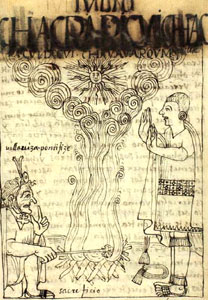 The Inca and pre-Inca civilizations of Peru demonstrated a profound grasp of astronomy, which significantly influenced their calendar systems and geometric practices.
The Inca and pre-Inca civilizations of Peru demonstrated a profound grasp of astronomy, which significantly influenced their calendar systems and geometric practices.
The Inca Empire devised a calendar that aligned with a solar year of 365 days, segmented into 12 lunar months, each consisting of 30 days, plus an additional five days to harmonize the calendar with the solar cycle. This calendar was integral to agricultural planning, religious ceremonies, and other critical events. A sophisticated intercalation method ensured its accuracy over time.
In the realm of geometry, the Incas were renowned for their masterful stone architecture, characterized by precise measurements and angles. They employed tools such as bronze chisels, stone hammers, and obsidian blades to achieve these exacting standards. Their construction consistency was maintained through a measurement system called the qullqa, based on the forearm's length.
Before the Inca, pre-Inca civilizations like the Moche had their own unique calendar and geometric systems. The Moche used a lunar-solar calendar, guided by the moon’s phases and the sun’s position, and their artistry included intricate pottery adorned with geometric shapes and patterns.
The Nazca civilization, known for their large-scale
geoglyphs, also had a sophisticated understanding of
geometry. Their designs incorporated precise lines and
shapes, which they created by removing the dark topsoil to
reveal the lighter-colored earth underneath.
Overall,
the Inca and pre-Inca civilizations of Peru had a deep
appreciation for astronomy, which they used to develop their
calendars and geometry. These systems were essential for
their daily lives, religious ceremonies, and important
events, and their legacy can still be seen in the impressive
stonework and designs that remain today.
The Inca calendar had 12
months of 30 days, with each month having its own festival. (The Incan year
began in December, and began with Capac Raymi, the magnificent festival.)
|
|
Illustrations from 1615 by
The "Indian Chronicler" Felipe Guaman
Poma de Ayala about the Months and the Festivals.
Finding his most persuasive medium to be the visual image,
he organizes his 1200-page Nueva corónica y buen gobierno
(New Chronicle and Good Government) around his 398
pen-and-ink drawings, all skillfully executed by his own hand.
For the archaeologist, Guaman Poma's drawings of native life
under the Incas are like photographs of the past.
| |
|
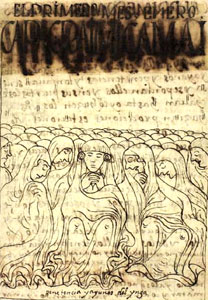
January. The Inca's penance and fasting.
During that month they offered sacrifices,
fasted, made penance, and covered their bodies
and heads with ashes, as the Incas still do
today, and went in procession to the temples of
the Sun, the Moon, their gods, and all huacas
(sacred place). |
|
|
|

February.
They made offerings of great quantities of gold and
silver. The Inca is represented kneeling bareheaded,
making an offering (perhaps to the stone of Huanacauri).
This is the wet season, if often rains... they used in
particular to visit the huacas of the high mountains and
the snows. |
|
|
| |
| |
|
|
| |
|

March.
The Inca is represented kneeling, about to "sacrifice
this black sheep.... The priests and sorcerers performed
many ceremonies, conversed with demons, deprived
themselves of salt for I know not how many days,
refrained from contact with women, and ate no fruit, |
|
|
|
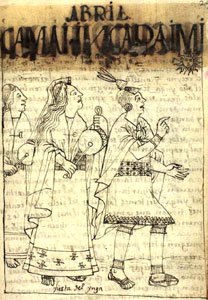
April.
Feast of the Incas. They sacrifice "red sheep." This is
"a very great feast to which all the lords, the princes,
and the poor Incas were invited; they ate, sang, and
danced on the main square." |
|
|
| |
| |
|
|
| |
|
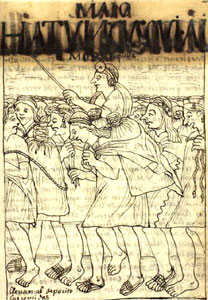
May.
The illustration shows Indians carrying supplies of
potatoes to the warehouses. It was the feast of the
Aimara; there was much singing and drunkenness. |
|
|
|
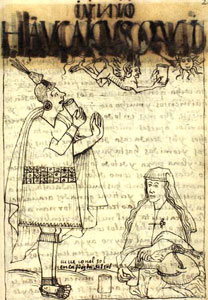
June.
The month of Inti-Raimi. The Inca is represented
"drinking with the Sun at the Feast of the Sun." |
|
|
| |
| |
|
|
| |
|

July.
The harvest festival. The illustration shows the High
Priest making an agrarian sacrifice before the Inca, who
has removed his headdress. |
|
|
|
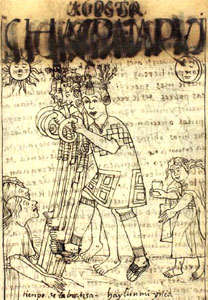
August.
The feast of tilling. Four Incas are shown digging while
a woman brings them chicha. (fermented beverage,
corn beer) |
|
|
| |
| |
|
|
| |
|
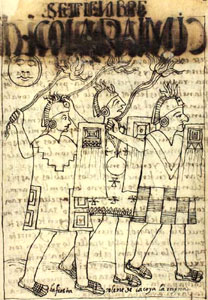
September.
Great Feast of the Moon, wife of the Sun. The town of
Cuzco is purified. The illustration shows three
purifiers banishing evil from the city with torches in
their hands. |
|
|
|
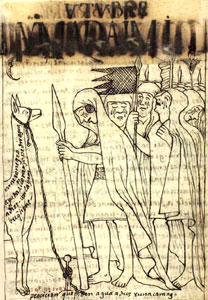
October.
Procession to ask God for water. "This hungry black
sheep helps men to weep and ask God for water." |
|
|
| |
| |
|
|
| |
|
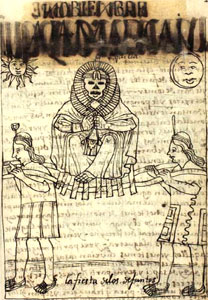
November.
Feast of dead. The mummies of dead kings are carried in
state. They are given food, they are clothed in rich
robes, with feathers on their heads; the people sing and
dance in their company and carry them through the
streets to the main square. |
|
|
|
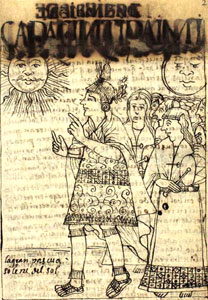
December.
Capac Inti-Raimi. This is " the great Feast of the Sun,
which is the king of the heavens, of the planets and
stars, and of all up above. Capac means king, Inti mean
Sun, and Raimi great feast. Much gold and silver plate
is sacrificed to the Sun; five hundred innocent
children, boys and girls, are buried alive, standing
upright, with these offerings of precious plate and
livestock. After the sacrifice, a great feast is held at
which they eat and drink to the Sun and dance in the
public squares of Cuzco and throughout the kingdom; and
those who become too drunk, or who turn their heads
towards the women, or who blaspheme and use bad language
are all put to death." |
|
|
|
Reference:
Guaman Poma - 'El primer Nueva corónica y buen gobierno'.
Post a comment
|